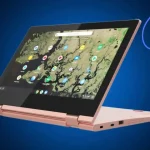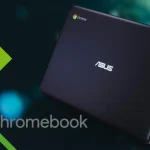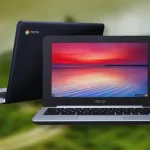Safari, a popular web browser from Apple Inc., is now available on Chromebooks, giving users a smooth and sophisticated way to explore the web. Safari gives Chromebook users a touch of grace with its sleek look, lightning-fast speed, and strong focus on privacy. The integration with Apple’s environment makes it easy to keep bookmarks, history, and tabs in sync across devices. This makes browsing on Macs, iPhones, iPads, and Chromebooks a smooth experience. Safari’s commitment to staying on the cutting edge of web technology makes sure that Chromebook users have access to the latest web standards. This makes it easy for Chromebook users to discover new content and apps. Safari makes sure that your surfing experience is safe and fun by preventing tracking and blocking pop-ups. Safari brings the best of Apple’s browser technology to the Chromebook environment, giving Chromebook users more power through its speed, efficiency, and focus on privacy.
Safari On Chromebook Step by Step:

1.Get the Crouton file. To open a shell, press Ctrl + Alt + T, type shell, and press Enter.
2.Put Ubuntu Linux in place. First, you need to download Ubuntu.
3.Set up Wine. Check your Ubuntu machine to see if you’re using the 32-bit or 64-bit version.
4.Type in this order: … Get the Safari browser.
A process called “Crouton” (Chromium OS Universal Chroot Environment) can be used to install Linux on a Chromebook. With this way, you can run Linux in addition to Chrome OS without replacing or changing the original system.
FAQs:
Can I install a different browser on Chromebook?
Ans:
Yes, ChromeOS works with many different web platforms, such as Google Chrome, Mozilla Firefox, Microsoft Edge, and more. You can get these browsers from the Chrome Web Store or their own websites and install them.

Chromebooks support running Android apps from the Google Play Store. This means you can easily install Mozilla Firefox on your Chromebook through the Play Store. Here’s how you can do it:
1.Open the Google Play Store: Click on the “Launcher” (the circle icon in the bottom-left corner of your screen) and look for the “Play Store” app. Click on it to open.
2.Search for Firefox: In the Play Store, use the search bar to look for “Mozilla Firefox.” Type “Firefox” and hit Enter.
3.Install Firefox: In the search results, click on “Mozilla Firefox” to open the app page. Click on the “Install” button to download and install Firefox on your Chromebook.

4.Open Firefox: After the installation is complete, you can find the Firefox app in your app launcher or shelf (the bottom bar with icons). Click on the Firefox icon to launch the browser.
5.Set Firefox as Default Browser (Optional): If you prefer using Firefox as your default browser, go to “Settings” > “Apps” > “Default apps.” Under “Web browser,” choose “Firefox” from the list.
Microsoft Edge is officially available for Chromebooks through the Google Play Store, provided that your Chromebook supports Android apps. Here’s how you can install Microsoft Edge on your Chromebook:
1.Check Compatibility: Open the Google Play Store on your Chromebook and search for “Microsoft Edge.” If the app appears in the search results, it means your Chromebook supports Android apps, and you can proceed with the installation.
2.Install Microsoft Edge: Click on the “Install” button next to the Microsoft Edge app in the Play Store to download and install it on your Chromebook.
3.Launch Microsoft Edge: After installation, you can find the Microsoft Edge app in your app launcher or shelf. Click on the Edge icon to launch the browser.

4.Sign In: If you have a Microsoft account, you can sign in to sync your bookmarks, history, and settings across devices. If you don’t have a Microsoft account, you can still use Microsoft Edge as a standalone browser.
Is Safari better then Chrome?
Ans:
If speed and being able to change things with add-ons are important to you, Chrome may be a better pick. Safari is the best choice if you care more about stability and privacy and only use Apple products.
The comparison between Safari and Chrome can vary depending on individual preferences and specific use cases. Both browsers have their strengths and weaknesses, so it ultimately comes down to what features and capabilities matter most to you. Here are some points to consider:

**Safari:**
– **Integration with Apple Ecosystem:** Safari is tightly integrated with Apple devices and services, offering seamless syncing of bookmarks, history, and passwords across iPhones, iPads, and Macs. If you are heavily invested in the Apple ecosystem, Safari may provide a more unified experience.
– **Battery Efficiency:** Safari is known for its energy efficiency on macOS devices, which can lead to longer battery life compared to Chrome.
– **Privacy and Security:** Safari has strong privacy features, including Intelligent Tracking Prevention and built-in privacy reports, aimed at enhancing user privacy and security.

**Chrome:**
– **Cross-Platform Support:** Chrome is available on various operating systems, including Windows, macOS, Linux, Android, and iOS. This cross-platform support makes it a versatile choice if you use multiple devices and platforms.
– **Extensions and Add-Ons:** Chrome boasts an extensive library of extensions and add-ons, providing users with a wide range of tools and features to customize their browsing experience.
– **Developer Tools:** Chrome’s Developer Tools are highly regarded and widely used by developers for debugging and optimizing web applications.
– **Compatibility:** Some websites and web applications are optimized for Chrome, which may provide a smoother experience when using those services.
Ultimately, the “better” browser depends on your individual needs and preferences. If you prioritize tight integration with Apple devices and strong privacy features, Safari may be the better choice. On the other hand, if you prefer cross-platform support, a vast array of extensions, and developer tools, Chrome might be more suitable. Feel free to try both browsers and see which one aligns better with your browsing habits and requirements.
Can I put Firefox on my Chromebook?

Ans:
Firefox is one of the web browsers you can use on ChromeOS. It has features like better defense against tracking. On most current Chromebooks, you can use both the Linux version of Firefox and the Android version.
Firefox on your Chromebook by installing it from the Google Play Store (if your Chromebook supports Android apps) or by using the Linux version of Firefox. Here’s how you can do it:
Method 1: Installing Firefox from the Google Play Store (For Android-Compatible Chromebooks)
1.Open the Google Play Store on your Chromebook.
2.Search for “Firefox” in the Play Store.
3.Click on “Install” to download and install Firefox on your Chromebook.
4.Once the installation is complete, you can find the Firefox app in your app launcher or shelf. Click on the Firefox icon to launch the browser.
Method 2: Installing Firefox using Linux (For Linux-Compatible Chromebooks)
1.Enable Linux on your Chromebook. Go to “Settings” > “Advanced” > “Developers” > “Linux development environment,” and follow the instructions to set up Linux.
2.Open the Linux terminal on your Chromebook.

3.Type the following command to update the Linux package list:
Sql
sudo apt update
4.Type the following command to install Firefox:
sudo apt install firefox
5.Once the installation is complete, you can launch Firefox by typing firefox in the Linux terminal.

In the end, the Chrome web browser is the main focus of the browsing experience on Chromebooks. Chrome has an easy-to-use design, runs smoothly, and works well with Google services. It works with many web standards and has a large set of extensions, which makes it easy to use in many ways. Even though some Chromebooks may have other browsers like Safari and Microsoft Edge, Chrome is still the usual and best choice. With its ease of use, speed, and comfort, Chrome makes it easy and quick for Chromebook users to browse the web, making it a reliable partner for all their browsing needs.





